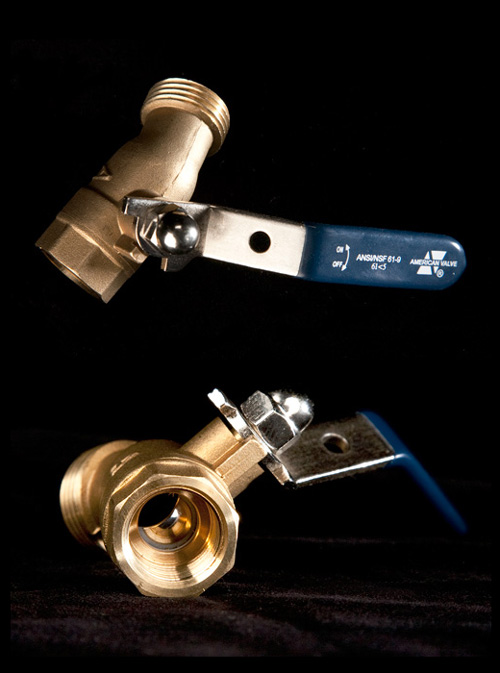
 |
|
Commercial Photography · Aerial Photography · Studio Rental · Classes |


The other day I was at the hardware store, buying some cover plates for outlet boxes, when I decided that my next article should be about going beyond the basic catalog shot, even when shooting really mundane stuff. I thought "What could be more boring than plumbing?" So I went to the plumbing section to find something that was plain, but could be made interesting, and I found a quarter-turn ½" hose bibb (translation: a spigot!) that was calling out to me to be photographed. No, really. It was. I heard it.
So step one was to photograph it the way it would be for your typical production catalog shot. White background, simple lighting, nothing done to the product to make it "show" better. And the result is the image at left. If you're interested, the set up for shooting it is on the right. Two softboxes lighting it from either side, and a ring-flash on the camera, shot on a sheet of white foam-core propped at a slight angle on the product table. No real thought involved, total setup and shooting time about 15 minutes. If you're shooting a thousand widgets for a catalog or newspaper insert, this is probably good enough, and certainly will give you quick throughput. I could shoot more items about that size at a rate of one every minute or two.
But it's boring!


You can make it a little more interesting just by adding a piece of black velvet for your background. Same basic shot, but you don't normally see it in black, and it does make the brass "pop" a little more. Take it a little further: mount the spigot on a pipe nipple (conveniently zip-tied to a boom stand), and use a little glycerine to make a drop hanging on the end of the spigot. (Why glycerin? Water would work, but you have to work a little harder to get the shot. Glycerin is more viscous and so gives better drips.) Now you know its application. It's not just a widget anymore, it's a hose fitting.


Or maybe you decide to get a little more artistic in the lighting. Set off the texture better by turning off the ring-flash. Highlight the threads and the actual ball inside the valve with edigier lighting and better angles. Add some highlights with an un-softened light, and position the spigot at oblique angles that show the opreation of the valve while also providing more interesting lines and angles to your composition. Provide two views to show more detail. Sure, the lighting is a little more complicated (see bottom right, and note the ring flash wasn't used), and it took maybe 15 or 20 minutes more to get the setup right. But now it looks, well, interesting (at least to me...). It's not just a stock catalog shot anymore. It has personality. Given my druthers, this is the way I'd shoot it (adding in the tag if needed).
But if you'd rather have the traditional catalog shot, I can do that, too. And better (I hope you'd agree) than the typical poorly lit point-and-shoot image that is all too typical on websites and local advertisements. If a pictue is worth a thousand words, make sure the words are good ones, even if they are just describing plumbing! After all, it's YOUR plumbing, right?
Happy shooting!
-Art
Back to The Photographer's Journal
| ©2008 ArtSmith Photography, all rights reserved. | Home • Portfolio • About ASP • Capabilities • Pricing • Contact • Journal |